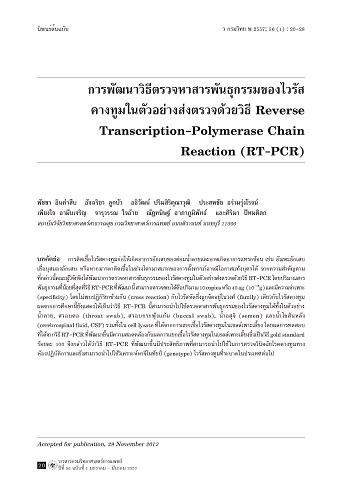Establishment of Reverse Transcription- Polymerase Chain Reaction (RT-PCR) for Detection of Mumps Nucleic Acid from Clinical Specimens
Keywords:
Mumps, RT-PCRAbstract
Infection with mumps virus results in swelling of salivary glands and further complications such as orchitis, meningitis or abortion within the first-trimester of pregnancy may occur. We, therefore, developed an RT-PCR method for detection of mumps genetic materials in clinical specimens. It was found that the limit of detection for our in-house RT-PCR method is 10 copies or 40 ag (10-18 g) and there is no cross – reactivity with measles virus, the other virus within the same family. It was demonstrated that the developed RT-PCR method is able to detect the genetic materials of mumps virus in saliva, throat swab, buccal swab, CSF, semen and mumps-infected cell lysate. The in-house RT-PCR technic showed 100% correlation with the gold standard method, i.e., viral isolation. The result from our study indicated that the developed RT-PCR method is useful for laboratory diagnosis as well as genetic characterization of mumps virus for the outbreak investigation in Thailand.
References
Carbone KM, Wolinsky JS. Mumps virus. In: Knipe DM, Howley PM, Griffin DE, et al. Field Virology vol. 1. 4th ed. Philadelphia, PA: Lippincott Williams&Wilkins; 2001. p. 1381-1400.
Weekly edidemiology record No. 45. 2001; 76(45): 345-356. [Online]. 2001; [12 screens]. Available from: URL: http://www.who.int/docstore/wer/pdf/2001/wer7645.pdf
รายงานการเฝ้าระวังทางระบาดวิทยาประจำสัปดาห์. ข้อมูลโรคที่เฝ้าระวังทางระบาดวิทยา จากบัตรรายงาน 506 พ.ศ. 2548. นนทบุรี: สำนักระบาดวิทยา กรมควบคุมโรค กระทรวงสาธารณสุข
Centers for Disease Control and Prevention. Mumps epidemic-United Kingdom, 2004-2005. MMWR Morbidity Mortality Weekly Report 2006; 55(7): p. 173-175.
Centers for Disease Control and Prevention. Mumps epidemic-Iowa, 2006. MMWR Morbidity Mortality Weekly Report 2006; 55(Dispatch): p. 1-3.
Public Health Agency of Canada. Information for Health Professional, National Summary, November 9, 2007 [Online]. Available from: URL: http://phac-aspc.gc.ca
Mumps. In: WHO-recommended standards for surveillance of selected vaccine-preventable diseases. WHO/V&B/03.01. Geneva, Sweitzerland: Vaccines and Biologicals, World Health Organization; 2003. p. 18-20.
Palacios G, Jabado O, Cisterna D, et al. Molecular identification of mumps virus genotype from clinical sample: standardized method of analysis. J Clin Microbiol 2005; 43(4): 1869-78.
Boriskin YS, Rice PS, Stabler RA, et al. DNA microarrays for virus detection in cases of central nervous system infection. J Clin Microbiol 2004; 42(12): 5811-8.
Watson-Crees G, Saunders A, Scott J, Lowe L, Pettipas J, Hatchette TF. Two successive outbreaks of mumps in Nova Scotia among vaccinated adolescents and young adults. CMAJ 2006; 175(5): 483-8.
Poggio GP, Rodriguez C, Cisterna D, Freire MC, Cello J. Nested PCR for rapid detection of mumps virus in cerebrospinal fluid from patients with neurological diseases. J Clin Microbiol 2000; 38(1): 274-8.
Krause CH, Eastick K., Ogilvie MM. Real-time PCR for mumps diagnosis on clinical specimens--comparison with results of convensional methods of virus detection and nested PCR. J Clin Virol 2006; 37(3): 184-9.
User manual pCR8/GW/TOPO TA cloning kit. Version E. USA: Invitrogen; 2006.
Standard Protocols for RT-PCR for Molecular Epidemiology of Mumps Virus. Measles, Mumps, Rubella and Herpes Branch, Atlanta: CDC.
Jin L, Beard S, Brown DW. Genetic heterogeneity of mumps virus in the United Kingdom: identification of two new genotypes. J Infect Dis 1999; 180(3): 829-33.
Boddicker JD, Rota PA, Kreman T, Wangeman A, Lowe L, Hummel KB, et al. Real-time reverse transcription-PCR assay for detection of mumps virus RNA in clinical specimens. J Clin Microbiol 2007; 45(9): 2902-8.
Cusi MG, Bianchi S, Valassina M, Santini L, Arnetoli M, Valensin PE. Rapid detection and typing of circulating mumps virus by reverse transcription/polymerase chain reaction. Res Virol 1996; 147(4): 227-32.
Uchida K, Shinohara M, Shimada S, Segawa Y, Doi R, Gotoh A. et al. Rapid and sensitive detection of mumps virus RNA directly from clinical samples by real-time PCR. J Med Virol 2005; 75(3): 470-4.
WHO/IVB/07.01. Manual for the laboratory diagnosis of measles and rubella virus infection. 2nd ed. Geneva: World Health Organization; 2007.
Henle G, Henle W, Wendell KK, Rosenberg P. Isolation of mumps virus from human beings with induced apparent or inapparent infections. J Exp Med 1948; 88(2): 223-32.
Carbone KM, Rubin S. Mumps virus. In: Knipe DM, Howley PM, editors. Field virology. 5th ed. Philadelphia: Lippincott Wiliams&Wilkins; 2007. p. 1527-50.
Bitsko RH, Cortese MM, Dayan GH, Rota PA, Lowe L, Iversen SC. et al. Detection of RNA of mumps virus during an outbreak in a population with a high level of measles, mumps, and rubella vaccine coverage. J Clin Microbiol 2008; 46(3): 1101-3.




